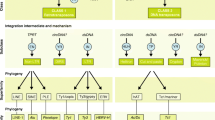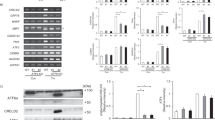Abstract
SIN3 was first identified by a mutation which suppresses the effects of an swi5 mutation on expression of the HO gene in Saccharomyces cerevisiae. We now show that a sin3 mutation also partially suppresses the effects of swi1 on HO transcription, and partially suppresses the growth defect and inositol requirement observed in swi1 mutants. This suggests that SIN3 and SWI1 may play opposite regulatory roles in controlling expression of many yeast genes. Yeast SIN3 has been shown to function as a negative transcriptional regulator of a number of yeast genes. However, expression of the yeast STE6 gene is reduced in a sin3 mutant strain. This suggests that SIN3 functions as a positive regulator for STE6 transcription, although this apparent activation function could be indirect. In order to understand how SIN3 functions in STE6 regulation, we have performed a genetic analysis. It has been previously demonstrated that MCM1 and STE12 are transcriptional activators of a-specific genes such as STE6, and we now show that SWI1 is also required for STE6 expression. Our data suggest that STE12 and SWI1 function in different pathways of activation, and that STE12 is epistatic to SIN3 and SWI1. We show that the activities of the Mcmlp and Stel2p activators are modestly reduced in a sin3 mutant strain, and that phosphorylation of the Stel2p activator is decreased in a sin3 mutant. Thus, it is possible that the decreased transcription of STE6 in sin3 mutants is due to the combined effect of the diminished activities of Mcmlp and Stel2p.
Similar content being viewed by others
References
Abrams E, Neigeborn L, Carlson M (1986) Molecular analysis of SNF2 and SNF5, genes required for expression of glucose-repressible genes in Saccharomyces cerevisiae. Mot Cell Biol 6:3643–3651
Alani E, Cao L, Kleckner N (1987) A method for gene disruption that allows repeated use of URA3 selection in the construction of multiply disrupted yeast strains. Genetics 116:541–545
Ammerer G (1990) Identification, purification, and cloning of a polypeptide (PRTF/GRM) that binds to mating-specific promoter elements in yeast. Genes Dev 4:299–312
Berkower C, Michaelis S (1991) Mutational analysis of the yeast a-factor transporter STE6, a member of the ATP binding cassette (ABC) protein superfamily. EMBO J 10:3777–3785
Boeke JD, LaCroute F, Fink GR (1984) A positive selection for mutants lacking orotidine-5′-phosphate decarboxylase activity in yeast: 5-fluoro-orotic acid resistance. Mol Gen Genet 197:345–346
Bowdish KS, Mitchell AP (1993) Bipartite structure of an early meiotic upstream activation sequence from Saccharomyces cerevisiae. Mol Cell Biol 13:2172–2181
Breeden L, Nasmyth K (1987) Cell cycle control of the yeast HO gene: cis- and trans-acting regulators. Cell 48:389–397
Bruhn L, Hwang-Shum J-J, Sprague GF Jr (1992) The N-terminal 96 residues of MCM1, a regulator of cell type-specific genes in Saccharomyces cerevisiae, are sufficient for DNA binding, transcriptional activation, and interaction with al. Mol Cell Biol 12:3563–3572
Cairns BR, Kim Y-J, Sayre MH, Laurent BC, Kornberg RD (1994) A multisubunit complex containing the SWI1/ADR6, SWI2/SNF2, SWI3, SNF5, and SNF6 gene products isolated from yeast. Proc Natl Acad Sci USA 91:1950–1954
Company M, Adler C, Errede B (1988) Identification of a Tyl regulatory sequence responsive to STE7 and STE12. Mol Cell Biol 8:2545–2554
Dohrmann PR, Butler G, Tamai K, Dorland S, Greene JR, Thiele DJ, Stillman DJ (1992) Parallel pathways of gene regulation: the homologous regulators SWI5 and ACE2 differentially control transcription of HO and chitinase. Genes Dev 6:93–104
Dolan JW, Fields S (1990) Overproduction of the yeast STE12 protein leads to constitutive transcriptional induction. Genes Dev 4:492–502
Dolan JW, Fields S (1991) Cell-type-specific transcription in yeast. Biochim Biophys Acta 1088:155–169
Elble R, Tye BK (1991) Both activation and repression of a-mating-type-specific genes in yeast require transcription factor Mcml. Proc Natl Acad Sci USA 88:10966–10970
Errede B (1993) MCM1 binds to a transcriptional control element in Ty1. Mol Cell Biol 13:57–62
Errede B, Ammerer G (1989) STE12, a protein involved in celltype-specific transcription and signal transduction in yeast, is part of protein-DNA complexes. Genes Dev 3:1349–1361
Fassler JS, Winston F (1989) The Saccharomyces cerevisiae SPT13/GAL11 gene has both positive and negative regulatory roles in transcription. Mol Cell Biol 9:5602–5609
Fields S, Herskowitz S (1987) Regulation by the yeast mating-type locus of STE12, a gene required for cell-type specific expression. Mot Cell Biol 7:3818–3821
Fields S, Chaleff DT, Sprague GFJ (1988) Yeast STE7, STE11, and STE12 genes are required for expression of cell-type-specific genes. Mol Cell Biol 8:551–556
Gonzalez GA, Montminy MA (1989) Cyclic AMP stimulates somatostatin gene transcription by phosphorylation of CREB at serine 133. Cell 59:675–680
Guarente L, Lalonde B, Gifford P, Alani E (1984) Distinctly regulated tandem upstream activation sites mediate catabolite repression of the CYC1 gene of S. cerevisiae. Cell 36:503–511
Hanes SD, Brent R (1989) DNA specificity of the bicoid activator protein is determined by homeodomain recognition helix residue 9. Cell 57:1275–1283
Herskowitz I (1989) A regulatory hierarchy for cell specialization in yeast. Nature 342:749–757
Hudak K, Lopes J, Henry S (1994) A pleiotropic phospholipid biosynthetic regulatory mutation in Saccharomyces cerevisiae is allelic to sin3 (sdi1, ume4, rpd1). Genetics 136:475–483
Hwang-Shum JJ, Hagen DC, Jarvis EE, Westby CA, Sprague GFJ (1991) Relative contributions of MCMl and STEl2 to transcriptional activation of a- and α-specific genes from Saccharomyces cerevisiae. Mol Gen Genet 227:197–204
Ito H, Fukada Y, Murata K, Kimura A (1983) Transformation of intact yeast cells treated with alkali cations. J Bacteriol 153:163–168
Jarvis EE, Clark KL, Sprague GF (1989) The yeast transcription activator PRTF, a homolog of the mammalian serum response factor, is encoded by the MCM1 gene. Genes Dev 3:936–945
Jiang YW, Stillman DJ (1992) Involvement of the SIN4 global transcriptional regulator in the chromatin structure of Saccharomyces cerevisiae. Mol Cell Biol 12:4503–4514
Jones JS, Prakash L (1990) Yeast Saccharomyces cerevisiae selectable markers in pUCl8 polylinkers. Yeast 6:363–366
Kuchler K, Sterne RE, Thorner J (1989) Saccharomyces cerevisiae STE6 gene product: a novel pathway for protein export in eukaryotic cells. EMBO J 8:3973–3984
Kurtz S, Shore D (1991) RAPl protein activates and silences transcription of mating-type genes in yeast. Genes Dev 5:616–628
Laurent BC, Carlson M (1992) Yeast SNF2/SWI2, SNF5, and SNF6 proteins function coordinately with the gene-specific transcriptional activators GAL4 and Bicoid. Genes Dev 6:1707–1715
Ma J, Ptashne M (1987) Deletion analysis of GAL4 defines two transcriptional activating segments. Cell 48:847–863
Marais R, Wynne J, Treisman R (1993) The SRF accessory protein Elk-1 contains a growth factor-regulated transcriptional activation domain. Cell 73:381–393
McGrath JP, Varshavsky A (1989) The yeast STE6 gene encodes a homologue of the mammalian multidrug resistance P-glycoprotein. Nature 340:400–404
Miles J, Formosa T (1992) Evidence that POB1, a Saccharomyces cerevisiae protein that binds to DNA polymerase a, acts in DNA metabolism in vivo. Mol Cell Biol 12:5724–5735
Mylin LM, Bhat JP, Hopper JE (1989) Regulated phosphorylation and dephosphorylation of GAL4, a transcriptional activator. Genes Dev 3:1157–1165
Nasmyth K, Stillman D, Kipling D (1987) Both positive and negative regulators of HO transcription are required for mothercell-specific mating-type switching in yeast. Cell 48:579–587
Natsoulis G, Dollard C, Winston F, Boeke JD (1991) The products of the SPTl0 and SPT21 genes of Saccharomyces cerevisiae increase the amplitude of transcriptional regulation at a large number of unlinked loci. New Biol 3:1249–1259
Nawaz Z, Baniahmad C, Burris TP, Stillman DJ, O'Malley BW, Tsai M-J (1994) The yeast SIN3 gene product negatively regulates the activity of the human progesterone receptor and positively regulates the activities of GAL4 and the HAPI activator. Mol Gen Genet
Passmore S, Elble R, Tye B-K (1989) A protein involved in minichromosome maintenance in yeast binds a transcriptional enhancer conserved in eukaryotes. Genes Dev 3:921–935
Peterson CL, Dingwall A, Scott MP (1994) Five SWI/SNF gene products are components of a large multisubunit complex required for transcriptional enhancement. Proc Natl Acad Sci USA 91:2905–2908
Peterson CL, Herskowitz I (1992) Characterization of the yeast SWI1, SUI2 and SWI3 genes, which encode a global transcriptional activator of transcription. Cell 68:573–583
Peterson CL, Kruger W, Herskowitz I (1991) A functional interaction between the C-terminal domain of RNA polymerase 11 and the negative regulator SIN1. Cell 64:1135–1143
Primig M, Winkler H, Ammeter G (1991) The DNA-binding and oligomerisation domain of MCM1 is sufficient for its interaction with other regulatory proteins. EMBO J 10:4209–4218
Rose MD, Winston F, Heiter P (1990) Methods in yeast genetics. A laboratory course manual. Cold Spring Harbor Laboratory Press, Plainview, New York
Rubin GM (1974) Three forms of the 5.8S ribosomal RNA species in Saccharomyces cerevisiae. Eur J Biochem 41:197–202
Sengupta P, Cochran BH (1991) MATα1 can mediate gene activation by a-mating factor. Genes Dev 5:1924–1934
Sikorski RS, Hieter P (1989) A system of shuttle vectors and yeast host strains designed for efficient manipulation of DNA in Saccharomyces cerevisiae. Genetics 122:19–27
Song D, Dolan JW, Yuan YL, Fields S (1991) Pheromone-dependent phosphorylation of the yeast STEl2 protein correlates with transcriptional activation. Genes Dev 5:741–750
Sorger PK, Pelham HRB (1988) Yeast heat shock factor is an essential DNA-binding protein that exhibits temperature-dependent phosphorylation. Cell 54:855–864
Stern M, Jensen R, Herskowitz I (1984) Five SW1 genes are required for expression of the HO gene in yeast. J Mol Biol 178:853–868
Sternberg PW, Stern MJ, Clark I, Herskowitz I (1987) Activation of the yeast HO gene by release from multiple negative controls. Cell 48:567–577
Strich R, Slater MR, Esposito RE (1989) Identification of negative regulatory genes that govern the expression of early meiotic genes in yeast. Proc Natl Acad Sci USA 86:10018–10022
Suzuki Y, Nogi Y, Abe A, Fukasawa T (1988) GAL11 protein, an auxiliary transcription activator for genes encoding galactosemetabolizing enzymes in Saccharomyces cerevisiae. Mol Cell Biol 8:4991–4999
Treisman R, Ammerer G (1992) The SRF and MCM1 transcription factors. Curr Opinion Genet Dev 2:221–226
Vidal M, Strich R, Esposito RE, Gaber RF (1991) RPD1 (SIN3/UME4) is required for maximal activation and repression of diverse yeast genes. Mol Cell Biol 11:6306–6316
Wang H, Stillman DJ (1990) In vitro regulation of a SIN3-dependent DNA-binding activity by stimulatory inhibitory factors. Proc Natl Acad Sci USA 87:9761–9765
Wang H, Stillman DJ (1993) Transcriptional regulation in Saccharomyces cerevisiae by a SIN3-LexA fusion protein. Mol Cell Biol 13:1805–1814
Wang H, Clark I, Nicholson PR, Herskowitz I, Stillman DJ (1990a) The Saccharomyces cerevisiae SIN3 gene, a negative regulator of HO, contains four paired amphipathic helix motifs. Mol Cell Biol 10:5927–5936
Wang H, Nicholson PR, Stillman DJ (1990b) Identification of a yeast DNA-binding protein involved in transcriptional regulation. Mol Cell Biol 10:1743–1753
West RW Jr, Yocum RR, Ptashne M (1984) Saccharomyces cerevisiae GAL1-GALl0 divergent promoter region: location and function of the upstream activating sequence UASG. Mol Cell Biol 4:2467–2478
Wilson KL, Herskowitz I (1986) Sequences upstream of the STE6 gene required for its expression and regulation by the mating type locus in Saccharomyces cerevisiae. Proc Natl Acad Sci USA 83:2536–2540
Winston F, Carlson M (1992) Yeast SNF/SWI transcriptional activators and the SPT/SIN chromatin connection. Trends Genet 8:387–391
Yoshimoto H, Ohmae M, Yamashita I (1992) The Saccharomyces cerevisiae GAM2/SIN3 protein plays a role in both activation and repression of transcription. Mol Gen Genet 233:327–330
Yu G, Fassler JS (1993) SPT13 (GALl1) of Saccharomyces cerevisiae negatively regulates activity of the MCM1 transcription factor in TY1 elements. Mol Cell Biol 13:61–71
Author information
Authors and Affiliations
Rights and permissions
About this article
Cite this article
Wang, H., Reynolds-Hager, L. & Stillman, D.J. Genetic interactions between SIN3 mutations and the Saccharomyces cerevisiae transcriptional activators encoded by MCM1, STE12, and SWI1 . Molec. Gen. Genet. 245, 675–685 (1994). https://doi.org/10.1007/BF00297274
Received:
Accepted:
Issue Date:
DOI: https://doi.org/10.1007/BF00297274




